
a.
Find a trignometric model for International Falls.
a.
Answer to Problem 89E
Explanation of Solution
Given information:
The table shows the maximum daily high temperatures in Las Vegas
A model for the temperatures in Las Vegas is
Find a trignometric model for International Falls.
Calculation:
We are given with the data, which shows the maximum daily high temperatures in Las Vegas
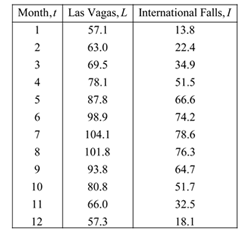
We are given with the model of temperature in Las Vegas.
Now to model the data for International Falls,
Amplitude
Period
Also,
Because maximum temperature occurs in seventh month,
So,
The average temperature is,
Hence, the model is
b.
Graph the data points.
How well does the model fit the data?
b.
Answer to Problem 89E
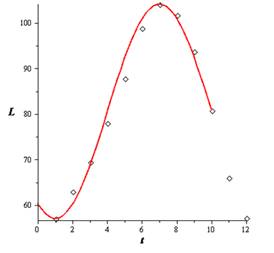
The model fits the data well.
Explanation of Solution
Given information:
The table shows the maximum daily high temperatures in Las Vegas
A model for the temperatures in Las Vegas is
Use a graphing utility to graph the data points and the model for the temperatures in Las Vegas. How well does the model fit the data?
Calculation:
Let us first plot the plots and graph the model of Las Vegas.
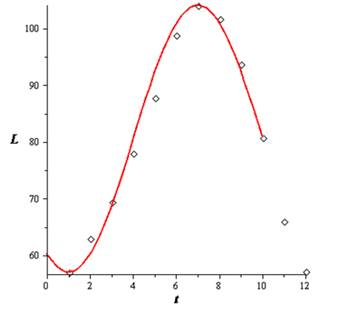
Hence, the model fits the data well.
c.
Graph the data points and the model for the temperatures in International Falls.
c.
Answer to Problem 89E
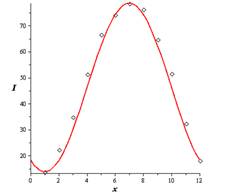
Explanation of Solution
Given information:
The table shows the maximum daily high temperatures in Las Vegas
A model for the temperatures in Las Vegas is
Use the graphing utility to graph the data points and the model for the temperatures in International Falls. How well does the model fit the data?
Calculation:
Let us first plot the plots and graph the model of International Falls.
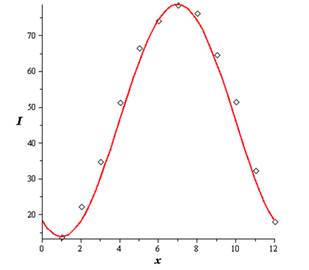
Hence, the result.
d.
Average maximum temperature.
d.
Answer to Problem 89E
Explanation of Solution
Given information:
The table shows the maximum daily high temperatures in Las Vegas
A model for the temperatures in Las Vegas is
Use the models to estimate the average maximum temperature in each city. Which term of the models did you use? Explain.
Calculation:
The annual average temperature is,
Las Vegas:
International Falls:
Hence, average temperature of Las Vegas is
e.
Period of each model.
e.
Answer to Problem 89E
Explanation of Solution
Given information:
The table shows the maximum daily high temperatures in Las Vegas
A model for the temperatures in Las Vegas is
What is the period of each model? Are the periods what you expected? Explain.
Calculation:
The period for both the model is
Yes, this is what we expected, as the number of months in a year is
Hence, the period for both the model is
f.
Which city has the greater variability in temperature throughout the year?
Factor of the models determines this variability.
f.
Answer to Problem 89E
International Falls.
Amplitude.
Explanation of Solution
Given information:
The table shows the maximum daily high temperatures in Las Vegas
A model for the temperatures in Las Vegas is
Which city has the greater variability in temperature throughout the year? Which factor of the models determines this variability? Explain
Calculation:
International Falls has greater variability,
Amplitude determines this factor.
Hence, greater the amplitude, greater is the variabilty.
Chapter 4 Solutions
EBK PRECALCULUS W/LIMITS
- x³-343 If k(x) = x-7 complete the table and use the results to find lim k(x). X-7 x 6.9 6.99 6.999 7.001 7.01 7.1 k(x) Complete the table. X 6.9 6.99 6.999 7.001 7.01 7.1 k(x) (Round to three decimal places as needed.)arrow_forward(3) (4 points) Given three vectors a, b, and c, suppose: |bx c = 2 |a|=√√8 • The angle between a and b xc is 0 = 135º. . Calculate the volume a (bxc) of the parallelepiped spanned by the three vectors.arrow_forwardCalculate these limits. If the limit is ∞ or -∞, write infinity or-infinity. If the limit does not exist, write DNE: Hint: Remember the first thing you check when you are looking at a limit of a quotient is the limit value of the denominator. 1. If the denominator does not go to 0, you should be able to right down the answer immediately. 2. If the denominator goes to 0, but the numerator does not, you will have to check the sign (±) of the quotient, from both sides if the limit is not one-sided. 3. If both the numerator and the denominator go to 0, you have to do the algebraic trick of rationalizing. So, group your limits into these three forms and work with them one group at a time. (a) lim t-pi/2 sint-√ sin 2t+14cos ² t 7 2 2 2cos t (b) lim sint + sin 2t+14cos = ∞ t-pi/2 2 2cos t (c) lim cost-√sin 2t+14cos² t = t-pi/2 2cos t (d) lim t→pi/2 cost+√ sin t + 14cos 2cos ² t = ∞ (e) lim sint-v sin 2 t + 14cos = 0 t-pi/2 (f) lim t-pi/2 sin t +√ sin 2sin 2 t 2 t + 14cos t 2sin t cost- (g)…arrow_forward
- Think of this sheet of paper as the plane containing the vectors a = (1,1,0) and b = (2,0,0). Sketch the parallelogram P spanned by a and b. Which diagonal of P represents the vector a--b geometrically?arrow_forward(1) (14 points) Let a = (-2, 10, -4) and b = (3, 1, 1). (a) (4 points) Using the dot product determine the angle between a and b. (b) (2 points) Determine the cross product vector axb. (c) (4 points) Calculate the area of the parallelogram spanned by a and b. Justify your answer. 1arrow_forward(d) (4 points) Think of this sheet of paper as the plane containing the vectors a = (1,1,0) and b = (2,0,0). Sketch the parallelogram P spanned by a and b. Which diagonal of P represents the vector ab geometrically? d be .dx adjarrow_forward
- (2) (4 points) Find all vectors v having length 1 that are perpendicular to both =(2,0,2) and j = (0,1,0). Show all work. a=arrow_forwardFor the following function, find the full power series centered at a of convergence. 0 and then give the first 5 nonzero terms of the power series and the open interval = f(2) Σ 8 1(x)--(-1)*(3)* n=0 ₤(x) = + + + ++... The open interval of convergence is: 1 1 3 f(x)= = 28 3x6 +1 (Give your answer in help (intervals) .)arrow_forwardFor the following function, find the full power series centered at x = 0 and then give the first 5 nonzero terms of the power series and the open interval of convergence. f(x) = Σ| n=0 9 f(x) = 6 + 4x f(x)− + + + ++··· The open interval of convergence is: ☐ (Give your answer in help (intervals) .)arrow_forward
- Let X be a random variable with the standard normal distribution, i.e.,X has the probability density functionfX(x) = 1/√2π e^-(x^2/2)2 .Consider the random variablesXn = 20(3 + X6) ^1/2n e ^x^2/n+19 , x ∈ R, n ∈ N.Using the dominated convergence theorem, prove that the limit exists and find it limn→∞E(Xn)arrow_forwardLet X be a discrete random variable taking values in {0, 1, 2, . . . }with the probability generating function G(s) = E(sX). Prove thatVar(X) = G′′(1) + G′(1) − [G′(1)]2.[5 Marks](ii) Let X be a random variable taking values in [0,∞) with proba-bility density functionfX(u) = (5/4(1 − u^4, 0 ≤ u ≤ 1,0, otherwise. Let y =x^1/2 find the probability density function of Yarrow_forward2. y 1 Ο 2 3 4 -1 Graph of f x+ The graph gives one cycle of a periodic function f in the xy-plane. Which of the following describes the behavior of f on the interval 39 x < 41 ? (Α B The function f is decreasing. The function f is increasing. The function f is decreasing, then increasing. D The function f is increasing, then decreasing.arrow_forward
 Calculus: Early TranscendentalsCalculusISBN:9781285741550Author:James StewartPublisher:Cengage Learning
Calculus: Early TranscendentalsCalculusISBN:9781285741550Author:James StewartPublisher:Cengage Learning Thomas' Calculus (14th Edition)CalculusISBN:9780134438986Author:Joel R. Hass, Christopher E. Heil, Maurice D. WeirPublisher:PEARSON
Thomas' Calculus (14th Edition)CalculusISBN:9780134438986Author:Joel R. Hass, Christopher E. Heil, Maurice D. WeirPublisher:PEARSON Calculus: Early Transcendentals (3rd Edition)CalculusISBN:9780134763644Author:William L. Briggs, Lyle Cochran, Bernard Gillett, Eric SchulzPublisher:PEARSON
Calculus: Early Transcendentals (3rd Edition)CalculusISBN:9780134763644Author:William L. Briggs, Lyle Cochran, Bernard Gillett, Eric SchulzPublisher:PEARSON Calculus: Early TranscendentalsCalculusISBN:9781319050740Author:Jon Rogawski, Colin Adams, Robert FranzosaPublisher:W. H. Freeman
Calculus: Early TranscendentalsCalculusISBN:9781319050740Author:Jon Rogawski, Colin Adams, Robert FranzosaPublisher:W. H. Freeman
 Calculus: Early Transcendental FunctionsCalculusISBN:9781337552516Author:Ron Larson, Bruce H. EdwardsPublisher:Cengage Learning
Calculus: Early Transcendental FunctionsCalculusISBN:9781337552516Author:Ron Larson, Bruce H. EdwardsPublisher:Cengage Learning





